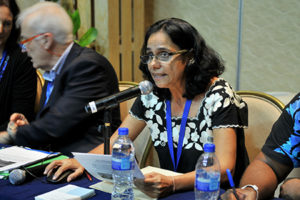
16 Jan Achieving conservation, sustainable livelihoods and food security in Marine Protected Areas
The Food and Agriculture Organization, along with the Fisheries Expert Group of the IUCN Commission on Ecosystem Management, held a side event during the recent UN Biodiversity Conference held in Cancún, Mexico, on December 5-17th 2016. The event “Small-scale fisheries communities and Aichi Target 11: Achieving conservation, sustainable livelihoods and food security in MPAs and other effective area-based measures (OEABMs)” was organized by a team including CCRN Director Anthony Charles. The session discussed (1) the appropriate mechanisms to mainstream community participation – notably of fishing communities and local fisher organizations – in MPAs and OEABM designation, planning and implementation and (2) the various contributions this will make to the achievement of the Aichi target No 11 and the Sustainable Development Goals (SDGs).

Dr. Minerva Arce-Ibarra discusses good practices for ensuring community participation in aquatic conservation, MPAs and OAEBMS.
The panel included prominent researchers in the field, including the Community Conservation Research Network researcher Dr. Minerva Arce-Ibarra. Panel presentations highlighted the important role of small-scale fishers as part of the solution to healthy marine ecosystems, particularly in coastal areas, placing emphasis on the Voluntary Guidelines for Securing Sustainable Small-scale Fisheries in the Context of Food Security and Poverty Eradication (the SSF Guidelines).
Dr. Arce-Ibarra’s presentation focused on a recent paper titled “Good practices for ensuring community participation in aquatic conservation, Marine Protected Areas and Other Area-Effective Based Measures: some Mexican experiences,” which was the result of a collaboration with Dr. Anthony Charles and Dr. Ratana Chuenpagdee (from Too Big to Ignore). The authors acknowledged that due to the multiple dimensions of marine protected areas, which generally include small-scale fisheries as well as the human rights of those who consider fishing as their main livelihood, people who study these issues should use interdisciplinary and transdisciplinary approaches in such a way as to seek a true integration of the issues being address. Dr. Arce-Ibarra mentioned that participatory research approaches and community management of resources and ecosystems, which are used by researchers from the Community Conservation Research Network (CCRN) and Too Big to Ignore, contain both interdisciplinary and transdisciplinary elements.

Panellists at “Small-scale Fisheries and Aichi Biodiversity Target 11: The Importance of Livelihoods and Food Security in Marine Protected Areas (MPAs)” side event (Left to Right: Vivienne Solis, ICSF; Mitchell Lay, CNFO; Lena Westlund, FAO; Serge García, IUCN-CEM-FEG; Minerva Arce-Ibarra, ECOSUR; and Alifereti Tawake, Pacific LMMA Network).
Lena Westlund, FAO, discussed that achieving Aichi Biodiversity Target 11 on MPAs and other effective area-based measures (OEABMs) depends on mainstreaming effective fishing community participation, moderated the panel. Other panellists included: Serge García, IUCN-CEM-FEG, explained why mainstreaming community participation in MPAs and OEABMS is important, underscoring that communities have formal rights to ecosystem services and that human rights, including the right to food, should be secured if MPAs are to become successful. Alifereti Tawake, Pacific Locally Managed Marine Area (LMMA) Network, discussed the legal and institutional framework and processes enabling LMMAs, saying they are critical to help reduce the tragedy of the commons by facilitating adaptive management through fisheries associations. Mitchell Lay, Caribbean Network of Fisherfolk Organization (CNFO), shared the challenges of MPAs in the Caribbean, and mentioned they have benefited tourism more than fisheries, citing the example of the set up and expansion of an MPA in Belize where fishers’ cooperatives weakened as tourism blossomed impacting fishers’ livelihoods. Vivienne Solis, ICSF, Costa Rica, mentioned that SSF Guidelines have been useful in creating co-management structures and cited the formation of Marine Responsible Fishing Areas spearheaded by fishermen in Costa Rica which resulted in raising awareness, training, workshops and other activities to popularize the wider use of the SSF Guidelines in Central America.
During the discussion, participants noted that, inter alia: MPAs should consider equity within the fisheries supply chain, particularly in regards to middlemen; and that finding a solution to fish spoils en route to markets will also address fishing pressure. In particular, Dr. Arce-Ibarra stated that all the panellists addressed interesting, and complementary points of views that add to the Aichi Target 11*.
*Aichi Biodiversity Target 11: By 2020, at least 17 per cent of terrestrial and inland water, and 10 per cent of coastal and marine areas, especially areas of particular importance for biodiversity and ecosystem services, are conserved through effectively and equitably managed, ecologically representative and well connected systems of protected areas and other effective area-based conservation measures, and integrated into the wider landscapes and seascapes.
Information for this post was provided by Minerva Arce-Ibarra and was partially adapted from the International Institute for Sustainable Development (IISD) website about the event.


